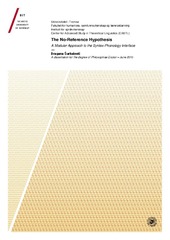| dc.contributor.advisor | Krämer, Martin | |
| dc.contributor.author | Šurkalović, Dragana | |
| dc.date.accessioned | 2016-02-08T11:22:35Z | |
| dc.date.available | 2016-02-08T11:22:35Z | |
| dc.date.issued | 2016-01-22 | |
| dc.description.abstract | This dissertation investigates the interface of syntax and phonology in a fully modular view of language, deriving the effects of syntactic structure on prosodification without referring to that structure in the phonological computation. It explores the effects of the Multiple Spell-Out Hypothesis and ‘syntax-all-the-way-down approaches’, specifically Nanosyntax, on the phonological computation. The dissertation addresses three issues for modularity: (i) phonology can see edges of syntactic constituents, (ii) phonology distinguishes between lexical and functional elements in syntax, and (iii) phonology recognizes Information Structure marking features. The No-Reference Hypothesis is presented as the solution. It states that phonological computation needs to proceed in phases in order to achieve domain mapping while maintaining an input to phonology consisting of purely phonological information. The dissertation provides an explicit account of how the outputs of different phases get linearized wrt each other, providing arguments that spell-out does not proceed in chunks but produces cumulative cyclic input to phonology. An analysis is provided, using data from English, Kayardild and Ojibwa, showing how prosodic domains can be derived from phases by phonological computation being faithful to the prosodification output of the previous phase. The analysis is formalized by introducing Phase-Phase Faithfulness constraints to Optimality Theory. | en_US |
| dc.description.doctoraltype | ph.d. | en_US |
| dc.description.popularabstract | Avhandlingen utforsker interaksjon mellom syntaks og fonologi i et språksyn som tar det for gitt at språket er modulær, dvs. at fonologi ser ikke informasjon fra syntaks. Avhandlingen viser hvordan et «No-Reference Hypothesis» (NRH) kan forklare hvordan prosodiske strukturer er skapt i fonologi i de situasjonene hvor det ser ut som om at den ser syntaks, med bruk av eksempler fra Engelsk, Kayardild og Ojibwa. NRH bygger på Nanosyntaks teorien av syntaks, hvor tradisjonelle elementer som «ord», «verb» og «substantiv» eksisterer ikke, og viser hvordan vi kan bruke faser i det syntaktiske derivasjonen for å forklare fenomener i fonologi som er avhengige av disse elementer. Avhandlingen bidrar til ny kunnskap om språket ved å gi et helt modulært teori av syntaks-fonologi interaksjon, inkludert et forklaring av hvordan det hierarkiske struktur i syntaks blir til et lineær struktur i fonologi, og formaliserer den nye teorien innenfor Optimality Theory. | en_US |
| dc.description.sponsorship | The Center for Advanced Study in Theoretical Linguistics (CASTL) | en_US |
| dc.identifier.uri | https://hdl.handle.net/10037/8438 | |
| dc.identifier.urn | URN:NBN:no-uit_munin_8009 | |
| dc.language.iso | eng | en_US |
| dc.publisher | UiT Norges arktiske universitet | en_US |
| dc.publisher | UiT The Arctic University of Norway | en_US |
| dc.rights.accessRights | openAccess | |
| dc.rights.holder | Copyright 2016 The Author(s) | |
| dc.rights.uri | https://creativecommons.org/licenses/by-nc-sa/3.0 | en_US |
| dc.rights | Attribution-NonCommercial-ShareAlike 3.0 Unported (CC BY-NC-SA 3.0) | en_US |
| dc.subject | VDP::Humanities: 000::Linguistics: 010::Other linguistic disciplines: 039 | en_US |
| dc.subject | syntax-phonology interface | en_US |
| dc.subject | prosody | en_US |
| dc.subject | Optimality Theory | en_US |
| dc.subject | phases | en_US |
| dc.subject | modularity | en_US |
| dc.subject | Nanosyntax | en_US |
| dc.subject | linearization | en_US |
| dc.subject | VDP::Humaniora: 000::Språkvitenskapelige fag: 010::Andre språkvitenskapelige fag: 039 | en_US |
| dc.title | The No-Reference Hypothesis: A Modular Approach to the Syntax-Phonology Interface | en_US |
| dc.type | Doctoral thesis | en_US |
| dc.type | Doktorgradsavhandling | en_US |


 English
English norsk
norsk




